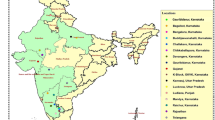Abstract
Fruit rots are possibly the most important diseases of pomegranates in Greece and worldwide. One of the aims of this study was to identify the pathogens causing pre- and postharvest fruit rots of pomegranate. The results showed that Pilidella granati was isolated from about 60 % of the preharvest rotted fruits without symptoms of cracking. Fungi of the genera Penicillium and Aspergillus niger predominated in rotted fruits with symptoms of cracking. In most of the postharvest rotted fruits, the symptoms developed from the calyx of the fruits. Botrytis cinerea was mainly isolated from these fruits (45 %). P. granati was isolated in 29 % of cases. These pathogens infected all parts of the fruits. Fungi of the genera Penicillium and Phoma sp. were isolated at a low percentage. Two or more of the above pathogens were simultaneously isolated from the same fruit in 15 % of cases. Propagules of the fungi P. granati, Penicillium spp., A. niger, B. cinerea, Alternaria spp., Cladosporium cladosporioides, and Aureobasidium pullulans were detected in the mummified fruit. In the calyx and mouldy stamens, most of the fungal colonies isolated were of the genus Penicillium. A number of colonies of the fungi A. alternata and C. cladosporioides and fewer colonies of the fungi A. niger, A. pullulans, B. cinerea and P. granati were also observed. Finally, the effectiveness of the fungicides tebuconazole, thiophanate methyl, azoxystrobin, cyproconazole and the mix pyrachlostrobin:boscalid to control postharvest fruit rots on pomegranate was investigated. No fungicide was effective in preharvest applications. In prestorage application, the fruits sprayed with tebuconazole or thiophanate methyl showed the least percentage of fruit rots of all treatments. Finally, no fungicide was effective to control fruit rots on pomegranates in poststorage applications.
Similar content being viewed by others
References
Bardas GA, Tzelepis GD, Lotos L, Karaoglanidis GS (2009a) First Report of Botrytis cinerea on pomegranate (Punica granatum) in Greece. Plant Dis 93:1347
Bardas GA, Tzelepis GD, Lotos L, Karaoglanidis GS (2009b) First Report of Penicillium glabrum on pomegranate (Punica granatum) in Greece. Plant Dis 93:1346
Çeliker MN, Uysal A, Çetinel B, Poyraz D (2012) Crown rot on pomegranate caused by Coniella granati in Turkey. Austral Plant Dis Notes 7:161–162
D’Aquino S, Schirra M, Palma A, Angioni A, Cabras P, Gentile A, Tribulato E (2009) Effectiveness of fludioxonil in control storage decay on pomegranate fruit. Acta Hortcult 818:313–318
Drogoudi P, Vasilakakis M, Thomidis T, Navrozidis E, Pantelidis G (2012) Handbook of pomegranate crop. http://www.nagref.gr/journals/publications/EGXEIRIDIO_RODIA.pdf
Gajbhiye MH, Prakash D, Kapadnis BP (2012) Identification of pomegranate fruit rot pathogens and an antagonist Lactococcus lactis ssp. cremoris PB6. J Mycol Plant Pathol 42:469–478
Greek Ministry of Agricultural Development and Food (2013) http://www.minagric.gr/index.php/el/
Hauke K, Creemers P, Brugmans W, Van Laer S (2004) Signum, a new fungicide with interesting properties in resistance management of fungal diseases in strawberries. Commun Agri Appl Biol Sci 69:743–755
Khokhar I, Bajwa R, Nasim G (2013) New report of Penicillium implicatum causing a postharvest rot of pomegranate fruit in Pakistan. Austral Plant Dis Notes. doi:10.1007/s13314-013-0091-0
Khokhar MK, Tetarwal JP (2012) Management of post-harvest black mould fruit rot of pomegranate (Punica granatum L.) caused by Aspergillus niger (Tieghem). Agric Res Rev 1:162–165
Labuda R, Hudec K, Piecková E, Mezey J, Bohovič R, Mátéová S, Lukáč S (2004) Penicillium implicatum causes a destructive rot of pomegranate fruits. Mycopathologia 157:217–223
Michailides TJ (2011) ucanr.edu/sites/Pomegranates/files/134012.pdf
Michailides TJ, Puckett R, Morgan D (2010) Pomegranate decay caused by Pilidiella granati in California. Phytopathology 100:S83–S83
Mirabolfathy M, Groenewald JZ, Crous PW (2012) First report of Pilidiella granati causing dieback and fruit rot of pomegranate (Punica granatum) in Iran. Plant Dis 96:416
Muñoz A, López-García B, Veyrat A, Luis González-Candelas L, Marcos FJ (2011) Comparative analysis of the sensitivity to distinct antimicrobials among Penicillium spp. causing fruit postharvest decay. Phytopathol Mediterr 50:392–407
Lolas M, Moggia C, Chacón F (1998) Harvest maturity, packaging and storage time related to calyx-end rot expression on Packham’s Triumph pears under refrigerated storage. Acta Horticult 475:459–470
Palou L, Guardado A, Montesinos-Herrero C (2010) First report of Penicillium spp. and Pilidiella granati causing postharvest fruit rot of pomegranate in Spain. New Dis Rep 22:21.
Seema Z, Sharma YR (2009) Incidence of wild pomegranate (Punica granatum L.) fruit rot caused by Penicillium herquei Bain. and Sartory from India. J Indian Phytopathol 62:533–535
Sharma RL, Tegta RK (2011) Incidence of dry rot of pomegranate in Himachal Pradesh and its management. Acta Hortcult 890:491–499
Thomidis T, Exadaktylou E (2011a) First report of Pilidiella granati on pomegranate with symptoms of crown rot in the Prefecture of Xanthi, Greece. Plant Dis 95:79
Thomidis T, Exadaktylou E (2011b) Occurrence of a fruit spot disease of pomogranates caused by Colletotrichum gloeosporiodes ((Penz) Sacc. in the Prefecture of Komotini, Greece. Plant Dis 95:872
Thomidis T, Michailides M, Exadaktylou E (2009) Contribution of pathogens to peach fruit rot in northern Greece and their sensitivity to iprodione, carbendazim, thiophanate-methyl and tebuconazole fungicides. J Phytopathol 157:194–200
Tziros GT, Tzavella-Klonari Κ (2007) Pomegranate fruit rot caused by Coniella granati confirmed in Greece. New Dis Rep 16:22
Tziros GT, Lagopodi ΑL, Tzavella-Klonari Κ (2007) Alternaria alternata fruit rot of pomegranate (Punica granatum) in Greece. New Dis Rep 15:14
Utikar PG, Sherkar BV, Shinde PA (1986) Evaluation of fungicides under field conditions against some fruit spotting-rotting fungi of pomegranate. Pesticide 20:27–29
Yehia HM (2013) Heart rot caused by Aspergillus niger through splitting in leathery skin of pomegranate fruit. African J Microbiol Res 7:834–837
Acknowledgment
This work was funded by O.P. Competitiveness and Entrepreneurship (EPAN ΙΙ), ROP Macedonia - Thrace, ROP Crete and Aegean Islands, ROP Thessaly - Mainland Greece - Epirus, ROP Attica
Author information
Authors and Affiliations
Corresponding author
Rights and permissions
About this article
Cite this article
Thomidis, T. Fruit rots of pomegranate (cv. Wonderful) in Greece. Australasian Plant Pathol. 43, 583–588 (2014). https://doi.org/10.1007/s13313-014-0300-0
Received:
Accepted:
Published:
Issue Date:
DOI: https://doi.org/10.1007/s13313-014-0300-0




